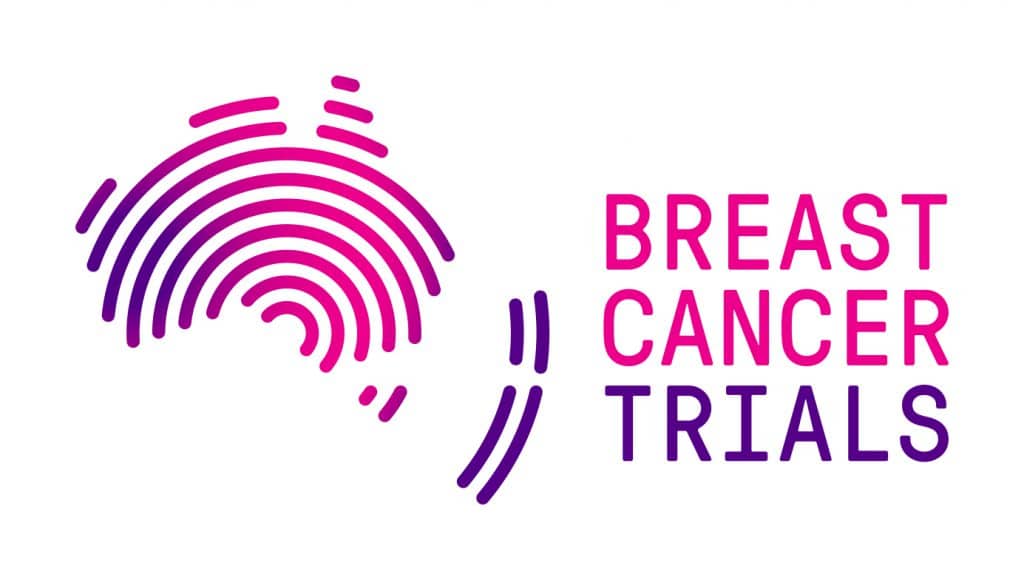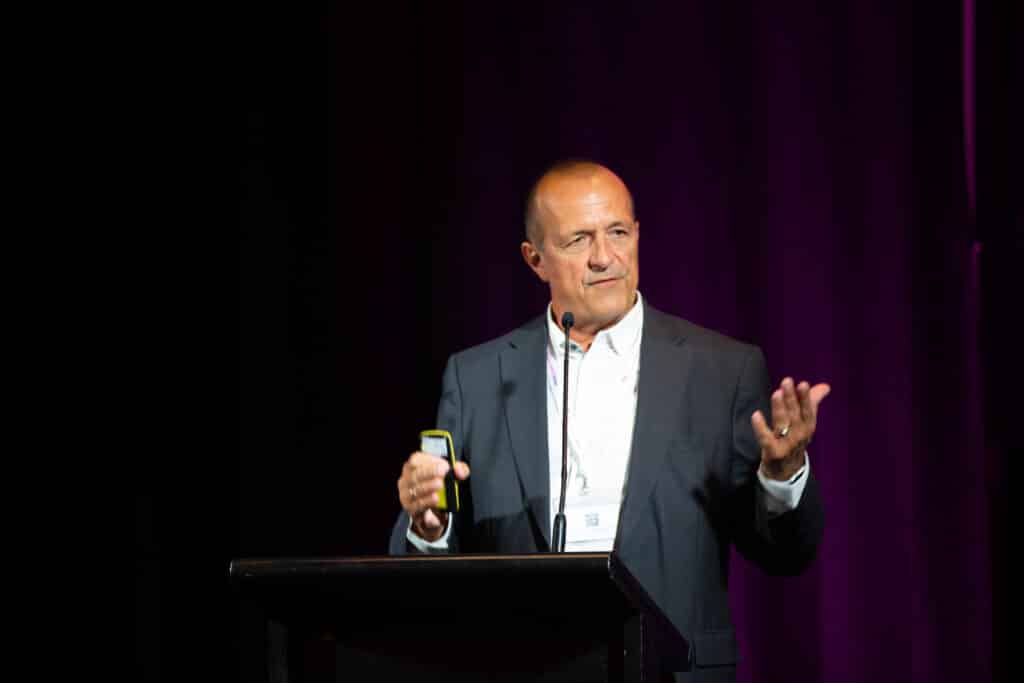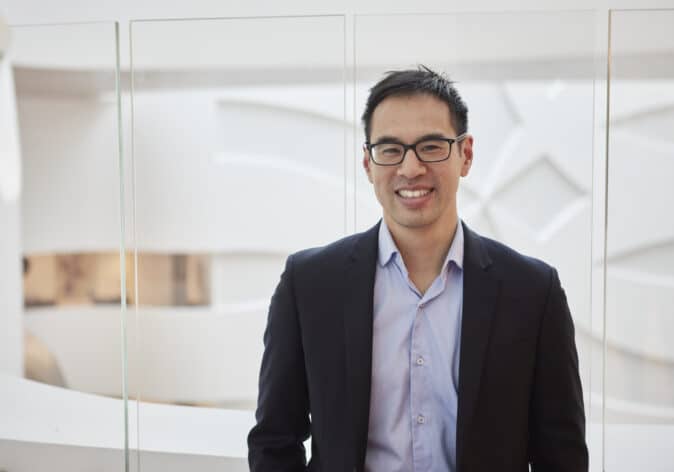Professor Philip Poortmans is a Radiation Oncologist at the University of Antwerp in Belgium. He completed his medical studies at the university and was trained as a Radiation Oncologist at the Middelheim and Vincentius hospitals in Antwerp.
Professor Poortmans was an international guest speaker at the Breast Cancer Trials 44th Annual Scientific Meeting in Auckland, New Zealand, and we asked him about his research in the area of axillary management.
“I’m Philip Poortmans and I consider myself rather as a breast cancer specialist with radiation oncology as well. I’m a true European, I’ve always lived in Belgium, did my training in Belgium, worked at two different places in the Netherlands, followed by three years in Paris, France.”
“And now I’m back close to my home in Antwerp in the north of Belgium. I love going to scientific meetings, whether they are educational or research oriented or more general. As long as the main topic is breast cancer because that’s really what interests me more.”
“The reason for going to meetings is a manifold. I love to share my experience and my knowledge, but I also like to absorb and to learn from others. And the social interaction between all healthcare professionals and the patients as well is so enriching that it cannot be replaced by what we witnessed during the COVID pandemics area in the virtual world.”
“We need to get together. We need to look in each other’s eyes and to speak live. And also of course, there is always a life in between the sessions during the breaks after the sessions. And this is so enriching. It’s a real way forward to build relations and to do the things together.”
Listen to the Podcast
We spoke with Professor Philip Poortmans about the management of the axilla.
What are some of the major milestones that have been made in the breast cancer space over the last decade?
“We learned over the last few decades that there is not one type of breast cancer. Breast cancer is a hugely variable disease with a lot of expressions. We call it the molecular subtypes, but you also have the stage, and you have the population in which the breast cancer is detected and treated. However, there are a lot of common grounds, and therefore we need to collaborate internationally.”
“A lot is similar, independent of where in the globe you are, or the patient is located and treated. That’s why we need to do the things together. Currently, performing clinical research is hugely complex because of a lot of reasons. It concerns privacy, insurance, administration, and all of that requires a huge amount of money, especially for having high-quality research, and a high level of evidence to back our research.”
“We also often need a large number of patients, or we need to do trials in a very small subgroup of the breast cancer patients. And these are all reasons that we need to do it together. We cannot do it in one country and then expect that other countries in another place of the world will simply adapt.”
“It has to be validated. Let’s work together for now and for the future of our patients. I’m very happy to come here because I had quite a few contributions and I still have some to go. Yesterday we had a session about clinical trials that are being developed currently, and most of them involve all of us.”
“They are multidisciplinary trials, and that’s why I was very happy that I could comment on one specifically. I was invited to give some critical comments on it, but I also could comment on the others. Today I will be speaking about the management of the axilla, and the management of the lymph nodes under the armpit.”
“This is a domain that has seen a huge evolution over the last decades. When I was in training, quite some years ago, treatment was standardised and the same for everybody, a complete surgical axillary clearance. This led to high morbidity, increased the levels of lymphedema of the swollen arm, and for most of the patients, it was absolutely unnecessary.”
“If you do surgery and the nodes are not involved, that’s good news, but you have the side effects. So we learned to do more targeted approaches.”
What will you be discussing at the conference?
“Nowadays In high-risk patients, we give the chemotherapy first and then we proceed to the rest of the treatment of the breast and of the lymph nodes. And this has challenged us to rethink the management of the axilla. And my topic today will be about how to manage the axilla after chemotherapy first, followed by limited surgery of the axilla, and then encountering a node that is involved by tumour, and what to do then.”
“The discussion question, which is valid worldwide, is do we need further surgery, or can we treat the patient just with radiation therapy alone? This is what I will explain later.”
“Tomorrow we will have other topics. And one of the topics is that less and less patients need mastectomy because thanks to screening, we find patients in an earlier stage of their diagnosis. So it can be done with breast conserving therapy. We know this is the preferred approach and patients who have more advanced breast cancer can be treated with chemotherapy, immunotherapy, and other approaches.”
“First the tumour is reduced, and then often they can be treated with breast conserving therapy. Nevertheless, there are some circumstances in which we need a mastectomy anyway. Those patients with the exception of very few, are entitled to a breast reconstruction.”
“And this is challenging, especially if the patients also need radiation therapy. Because it impacts on the complication rates, and it impacts on the cosmetic outcome. And one of the topics which is currently hot, is ‘why not, after the chemotherapy, give the radiation therapy first and then only after the radiation therapy proceed to the mastectomy and to the breast reconstruction?’”
“Already 10 years ago, it was launched that the forecast for the future would be that we can cure all breast cancer patients. The few breast cancer patients that we could not cure yet, should be turned in a chronic disease, which you can live with for decades with a high quality of life.”
“This will stepwise improve further. And this can be done thanks to early detection and screening. But this needs to be more focused. Living in Belgium, I live in the country with the highest rate of breast cancer of the entire world. And there are a number of explanations for that. And the explanations are quite simple, but we cannot solve them. The risk for breast cancer increases if we grow older. And the risk for breast cancer decreases with every pregnancy.”
“The younger the pregnancy, the higher the protective effect. So already 300 years ago, breast cancer was called the nun’s disease, because nuns had no children and lived much longer than the general population.”
“We cannot say, okay, we’re going to lower breast cancer by having a lot of children at a young age. That’s not the way. But we are working, for example, at hormonal interventions that might have an effect similar to the protective effect of a pregnancy. This is one of the things that I think will impact a number of patients. And then the patients who develop breast cancer will be treated much more individualized, much more optimized, not the same approach for all breast cancer patients.”
“It will be more effective for those who need it and less impacting for those who don’t need the intensive treatment. And that will ultimately lead to an even higher proportion than today of patients who survive the breast cancer, but not just survive it, also have a low impact of the burden of the treatments.”
“We know that we have improved a lot over the last decades, but still there are very challenging cases where we don’t have the real solution, either because finally the tumour is resistant to our treatments, or patients where the side effects of the treatments against the cancer have such an impact that there is life, but of low quality, so maybe even not worth living.”
Are you looking forward to the Trainee and Early-Career Day?
“I’m very happy that on Saturday we have a day for the young colleagues. It’s in the morning until the early afternoon session where we will discuss how our professional careers developed. And I’m happy that I can present my personal appreciation and thoughts about mentorship because we can be taught, we can learn, but the teacher is not a mentor for optimal professional development.”
“You need good teachers, but you also need extra guidance and mentorship, which is one of the approaches that is quite successful in that it’s highly demanding. Both from the mentor and the mentee, but it is also improving the satisfaction in your professional career.”
Support Us
Help us to change lives through breast cancer clinical trials research



